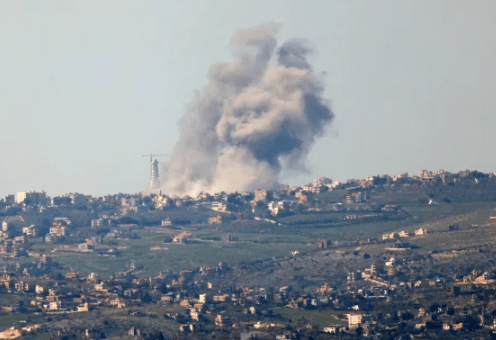New artillery attack as IAEA heads to Ukraine nuclear plant

A team from the UN nuclear watchdog headed to the Russian-controlled Zaporizhzhia nuclear plant in Ukraine on Monday.
Satellite images showed damage from an artillery attack to the roof of a building right next to the nuclear reactors at Ukraine’s besieged Zaporizhzhia plant, again increasing fears of a radiation disaster.
The latest attack on the plant occurred as a team from the UN’s nuclear watchdog headed on Monday to the facility as Russia and Ukraine traded accusations over shelling it.
New high-resolution satellite imagery collected by American company Maxar Technologies showed the damage at Europe’s largest nuclear power plant in Enerhodar, Ukraine.
Photos detailed the destruction to the roof of the building adjacent to several nuclear reactors at the Zaporizhzhia plant. They also showed bushfires outside of the main facility.
The Russian-installed administration of the region claimed Ukrainian forces hit the roof of the building used to store reactor fuel.
Radiation levels at the power plant were normal, however, and the situation at the site was under control, the RIA Novosti news agency cited Russian-installed officials as saying.
Conflict hotspot
The team from the International Atomic Energy Agency (IAEA) left Austria and arrived in Ukraine’s capital Kyiv on Monday.
“It is expected that the mission will start work at the Zaporizhzhia nuclear plant in the coming days,” ministry spokesman Oleg Nikolenko wrote on Facebook.
In Moscow, Kremlin spokesman Dmitry Peskov said Russia will ensure security of the IAEA mission and called on other countries to “raise pressure on the Ukrainian side to force it to stop threatening the European continent by shelling the territory of the Zaporizhzhia nuclear power plant and surrounding areas”.
Captured by Russian troops in March but run by Ukrainian staff, Zaporizhzhia has been a hotspot in a conflict that has settled into a war of attrition fought mainly in Ukraine’s east and south six months after Russia launched its invasion.
“We must protect the safety and security of Ukraine’s and Europe’s biggest nuclear facility,” Rafael Grossi, the director-general of IAEA, said in a post on Twitter.
An IAEA team he was leading will reach the plant on the Dnieper river near front lines in southern Ukraine later this week, Grossi said, without specifying the day.
The day has come, @IAEAorg‘s Support and Assistance Mission to #Zaporizhzhya (ISAMZ) is now on its way. We must protect the safety and security of #Ukraine’s and Europe’s biggest nuclear facility. Proud to lead this mission which will be in #ZNPP later this week. pic.twitter.com/tyVY7l4SrM — Rafael MarianoGrossi (@rafaelmgrossi) August 29, 2022
The IAEA tweeted separately the mission would assess physical damage, evaluate the conditions in which staff are working at the plant, and “determine functionality of safety & security systems”.
It would also “perform urgent safeguard activities”, a reference to keeping track of nuclear material.
“Without an exaggeration, this mission will be the hardest in the history of IAEA,” Ukrainian Foreign Minister Dmytro Kuleba said.
The United Nations and Ukraine have called for a withdrawal of military equipment and personnel from the nuclear complex to ensure it is not a target.
The two sides have for days exchanged accusations of each courting disaster with their attacks.
With fears mounting of a nuclear accident in a country still haunted by the 1986 Chornobyl disaster, Zaporizhzhia authorities are handing out iodine tablets and teaching residents how to use them in case of a radiation leak.
Radiation situation
Russian forces fired at Enerhodar, the city where the plant is located, the chief of staff of Ukraine’s President Volodymyr Zelenskyy, said late on Sunday on his Telegram channel alongside a video of firefighters dousing burning cars.
Russia’s defence ministry reported more Ukrainian shelling at the plant over the weekend. Nine shells fired by the Ukrainian artillery landed in the plant’s grounds, Russian defence ministry spokesman Igor Konashenkov said.
“At present, full-time technical personnel are monitoring the technical condition of the nuclear plant and ensuring its operation. The radiation situation in the area of the nuclear power plant remains normal,” he said in a statement.
‘Not appropriate’
The Russian state news agency cited authorities as saying they shot down a Ukrainian drone that planned to attack the nuclear-waste storage area at the plant.
Two of the plant’s reactors were cut off from the electrical grid last week because of shelling.
Ukraine’s nuclear energy agency, Energoatom, warned on Monday of Russian attempts to cover up their military use of the plant.
“The occupiers, preparing for the arrival of the IAEA mission, increased pressure on the personnel … to prevent them from disclosing evidence of the occupiers’ crimes at the plant and its use as a military base,” an Energoatom official said, adding four plant workers were wounded in Russian shelling of the city where they live.
Meanwhile, Russian foreign ministry spokeswoman Maria Zakharova lashed out against what she called “inadequate and untrue assessments” of the country’s role in agreeing to the IAEA mission.
She maintained Moscow signed off on the mission months ago while Western nations were attempting to frame the IAEA trip as a diplomatic breakthrough that Russia’s hand was forced to accept.
The White House said on Monday that Russia should agree to a demilitarised zone around the Ukrainian nuclear plant. A controlled shutdown of the plant would be the safest option, House National Security Council spokesman John Kirby told reporters.
“As we’ve said many times, a nuclear power plant is not the appropriate location for combat operations,” Kirby said.





